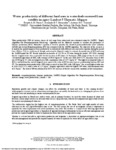Por favor, use este identificador para citar o enlazar este ítem:
http://www.alice.cnptia.embrapa.br/alice/handle/doc/1001287Registro completo de metadatos
| Campo DC | Valor | Lengua/Idioma |
|---|---|---|
| dc.contributor.author | FRANCO, R. A. M. | pt_BR |
| dc.contributor.author | HERNANDEZ, F. B. | pt_BR |
| dc.contributor.author | TEIXEIRA, A. H. de C. | pt_BR |
| dc.date.accessioned | 2014-12-02T11:11:11Z | pt_BR |
| dc.date.available | 2014-12-02T11:11:11Z | pt_BR |
| dc.date.created | 2014-12-02 | pt_BR |
| dc.date.issued | 2014 | pt_BR |
| dc.identifier.citation | Proceedings of SPIE, v. 9239, p. 92392E-1 - 92392E-7, 2014. | pt_BR |
| dc.identifier.isbn | 0277-786X | pt_BR |
| dc.identifier.uri | http://www.alice.cnptia.embrapa.br/alice/handle/doc/1001287 | pt_BR |
| dc.description | Water productivity (WP) of various classes of soil usage from watersheds was estimated using the SAFER - Simple Algorithm For Evapotranspiration Retrieving - algorithm and the Monteith equation to estimate the parameters of biomass production (BIO). Monteith?s equation is used to quantify the absorbed photosynthetically active radiation (APAR) and Actual Evapotranspiration (ET) was estimated with the SAFER algorithm. The objective of the research is to analyze the spatial-temporal water productivity in watersheds with different uses and soil occupation during the period from 1996 to 2010, in conditions of drought and using the Monteith model to estimate the production of BIO and using the SAFER model for ET. Results indicated an increase of 153.2% in ET value during the period 1997-2010, showing that the irrigated areas were responsible for this increase in ET values. In September 2000, image of day of year (DOY) 210 showed high values of BIO, with averages of 80.67 kg ha-1d-1. In the year 2010 (DOY:177), the mean value of BIO was 62.90 kg ha-1d-1, with an irrigated area with a maximum value of 227.5 kg ha-1d-1. The highest incremental values of BIO is verified from the start of irrigated areas equal to the value of ET, because there is a relationship between BIO and ET. The maximum water productivity (WP) value occurred in June/2001, with 3,08 kg m-3, the second highest value was in 2010 (DOY:177), with a value of 2,97 kg m-3. Irrigated agriculture show the highest WP value, with maximum value of 6.7 kg m-3. The lowest WP was obtained for DOY 267, because of the dry season with condition of low soil moisture. | pt_BR |
| dc.language.iso | eng | eng |
| dc.rights | openAccess | eng |
| dc.subject | Water productivity | pt_BR |
| dc.subject | Landsat 5 TM | pt_BR |
| dc.subject | Simple Algorithm For Evapotranspiration Retrieving | pt_BR |
| dc.title | Water productivity of different land uses in watersheds assessed from satellite imagery Landsat 5 Thematic Mapper. | pt_BR |
| dc.type | Artigo de periódico | pt_BR |
| dc.date.updated | 2014-12-02T11:11:11Z | pt_BR |
| dc.subject.nalthesaurus | Evapotranspiration | pt_BR |
| dc.subject.nalthesaurus | Biomass production | pt_BR |
| dc.subject.nalthesaurus | Land use change | pt_BR |
| dc.description.notes | Presented at the 16th Remote Sensing for Agriculture, Ecosystems, and Hydrology. | pt_BR |
| riaa.ainfo.id | 1001287 | pt_BR |
| riaa.ainfo.lastupdate | 2014-12-02 | pt_BR |
| dc.identifier.doi | 10.1117/12.2067459 | pt_BR |
| dc.contributor.institution | RENATO A. M. FRANCO, UNESP; FERNANDO B. T. HERNANDEZ, UNESP; ANTONIO HERIBERTO DE C TEIXEIRA, CNPM. | pt_BR |
| Aparece en las colecciones: | Artigo em periódico indexado (CNPM)  | |
Ficheros en este ítem:
| Fichero | Descripción | Tamaño | Formato | |
|---|---|---|---|---|
| 4202.pdf | 970,01 kB | Adobe PDF |  Visualizar/Abrir |









